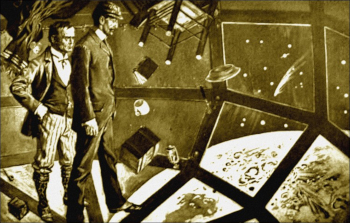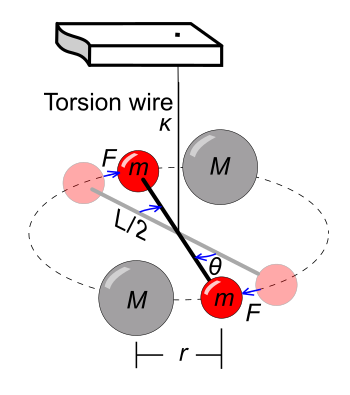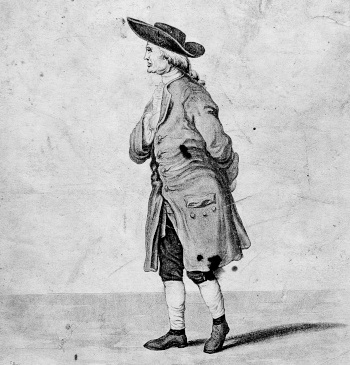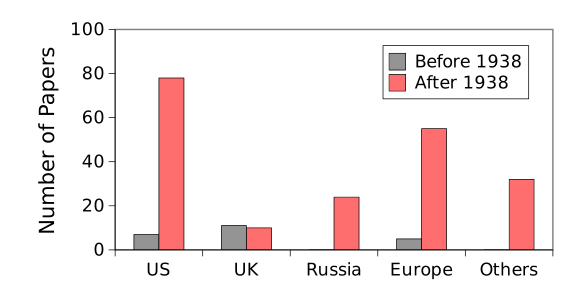The Gravitational Constant
July 31, 2023
Gravitation is an important
physical principle, but its
gravity shouldn't prevent us from making a few
jokes.
Why did the female physicist suspend her gravitation research for a short time? She was gravid.
I've been reading this book about anti-gravity and I can't seem to put it down.
The first joke could have been based on a
true story, but the
concept of anti-gravity is
fiction. Gravitational
force is always
attractive, and the
equivalence of the
gravitational properties of antimatter and normal matter has been confirmed to a high
precision.[1] As I wrote in a
previous article (Fictional Materials, April 21, 2016),
H. G. Wells (1866-1946) introduced the fictional material, Cavorite, in his 1901
novel,
The First Men in the Moon. Cavorite has an anti-gravity property that enables a voyage to the
Moon in a
spherical spaceship having movable
sheets of Cavorite to allow
steered propulsion.

While H. G. Wells was a successful author with an estimated net worth in today's money of about $5 million, the concept of the starving author is truer today than in his time.
There are so many books available, that any one author is drowning in a sea of many authors; and, things will only get worse. This blog, less the personal anecdotes from my research career, can be written nearly as well by an artificial intelligence agent. This is true for magazine articles and novels as well, and it's happening all the time.
(Illustration from the 1901 first edition of The First Men in the Moon, via Wikimedia Commons, showing weightlessness. Click for larger image.)
The launching point for gravitation in
modern physics was the 1687
publication of
Philosophiae Naturalis Principia Mathematica, commonly called
The Principia, by
Isaac Newton (1642-1727).
Newton's law of universal gravitation states that there's an attractive force between every bit of
matter in the
universe and every other, and that the force is
proportional to the
product of their
masses divided by the
square of the distance between their
centers (an
inverse square law). This force
F is
mathematically written as
 ,
,
n which
m1 and
m2 are the masses of the objects,
r is the distance between their centers, and
G is the gravitational constant. The commonly accepted value of
G is now 6.67430 x 10
-11 N·
m2/
kg2.[2]
The
first measurement of the gravitational constant was done a
century after Newton's Principia by
English chemist and physicist,
Henry Cavendish (1731-1810). This
Cavendish experiment, done in 1797-1798, was actually designed to measure the
density of the
Earth, but
G pops out with a simple
calculation. Since the gravitational force is so weak, Cavendish used a
torsion balance with two 2-inch-
diameter 1.61-
pound (0.73
kilogram)
lead spheres at the ends of a six
foot (1.8
meter)
wooden rod acting against two massive twelve
inch, 348-pound (158 kilogram) lead spheres (see figure). The gravitational attraction between the small and large spheres caused just a 0.16"
deflection of the balance.

Diagram of the torsion balance used in the Cavendish experiment.
In this figure, Θ is the deflection caused by the gravitational attraction of the two smaller lead spheres to the two larger ones.
Thin wires, with small torsion coefficients k, give more deflection; but, any wire needs to hold the weight of the two 1.61 pound (0.73 kg) lead spheres and their supporting wooden rod.
(Wikimedia Commons image by Chris Burks. Click for larger image.)
Cavendish performed many
experiments on
electricity, and
James Clerk Maxwell (1831-1879) was interested enough to
edit his research
notes a century later.[3]

(Wellcome Trust image M0014171 of Henry Cavendish, from a drawing in the British Museum, via Wikimedia Commons. Click for larger image.)
Henry Cavendish was an interesting man. He was extremely
shy, he
dressed in
clothes of an earlier period, and he was not able to
converse with
women,
communicating with his
female servants only in
writing, and having a back
staircase to avoid meeting any of them. In 2001,
neurologist,
Oliver Sacks (1933-2015),
speculated that Cavendish had
Asperger syndrome (AS), an
opinion embraced by other
professionals.[4-5] There's a present realization that AS people make good
scientists,
engineers,
mathematicians and
computer programmers, but not much research has been done on this topic.
A century after Cavendish, in 1894,
Charles Vernon Boys (1855-1944) determined
G to the unprecedented precision of five
significant digits.[6] Boys created his torsion balance with fine
fused quartz threads that he created using a
crossbow to
shoot quartz rods with
molten quartz at their tip.[6] As I wrote in an
earlier article (Strength of Materials, May 11, 2020), materials free of
surface cracks, such as freshly-drawn
glass fibers, have high
strength.
Gravity was a puzzle, also, to the
ancients, and a
timeline of gravity appears in a 2020
arXiv paper.[7] Always notable is
Aristotle's conception of gravity in which the
four elements seek their
natural place, the natural place of matter (
Earth) being at the center of the universe; which, at his time, was the center of the Earth.
Fire's place is, of course, in the
heavens.
Gravitational force is small; and, as a consequence, the gravitational constant is known to a very small precision, six significant digits, as compared with the twelve significant digits of the
fine structure constant. That's one reason why there are frequent experiments to get better values. In 2018,
Katelyn Horstman, now at the
California Institute of Technology (Pasadena, California), and
Virginia Trimble of the
University of California Irvine (Irvine, California) did an
analysis of papers on the gravitational constant with the results shown in the figure.[8]

Papers on the gravitational constant published before and after 1938. The United States is seen to be a world leader in such research. (Created using Gnumeric from data in ref. 8.)[8]
References:
- M. J. Borchert, J. A. Devlin, S. R. Erlewein, M. Fleck, J. A. Harrington, B. M. Latacz, F. Voelksen, E. J. Wursten, F. Abbass, M. A. Bohman, A. H. Mooser, M. Wiesinger, C. Will, K. Blaum, Y. Matsuda, C. Ospelkaus, W. Quint, J. Walz, Y. Yamazaki, C. Smorra, and S. Ulmer, "A 16-parts-per-trillion measurement of the antiproton-to-proton charge–mass ratio," Nature, vol. 601 (January 5, 2022), pp. 53-57, https://doi.org/10.1038/s41586-021-04203-w.
- Newtonian constant of gravitation, CODATA Internationally recommended 2018 values of the Fundamental Physical Constants, NIST website.
- Isobel Falconer, "Editing Cavendish: Maxwell and The Electrical Researches of Henry Cavendish," arXiv, April 28, 2015, https://doi.org/10.48550/arXiv.1504.07437.
- Oliver Sacks, "Henry Cavendish: An early case of Asperger’s syndrome?." Neurology, vol. 57, no. 7 (October 9, 2001), pp. 1347ff., DOI: https://doi.org/10.1212/WNL.57.7.1347.
- Hugo Lidbetter, "Henry Cavendish and Asperger’s syndrome: A new understanding of the scientist," Personality and Individual Differences, vol. 46, no. 8 (June, 2008), pp. 784-793, https://doi.org/10.1016/j.paid.2009.01.032.
- Isobel Falconer, "Historical Notes: The Gravitational Constant," Mathematics Today, vol. 58, no. 4 (In press, 2022), pp. 126-127. Also at arXiv, https://doi.org/10.48550/arXiv.2306.06411.
- Arshia Anjum, Sriman Srisa, and Saran Mishra, "The Timeline Of Gravity," arXiv, November 20, 2020, https://doi.org/10.48550/arXiv.2011.14014.
- Katelyn Horstman and Virginia Trimble, "A citation history of measurements of Newtons constant of Gravity," arXiv, November 26, 2018, https://doi.org/10.48550/arXiv.1811.10556.
Linked Keywords: Gravitation; gravity; physical law; physical principle; joke; female; physicist; research; gravid; reading (process); book; anti-gravity; truth; true story; concept; fiction; force; attractive; equality (mathematics); equivalence; gravitational properties of antimatter and normal matter; precision; H. G. Wells (1866-1946); novel; The First Men in the Moon; Moon; sphere; spherical; spacecraft; spaceship; sheet metal; steering; steered; propulsion; author; approximation; estimated; net worth; inflation; today's money; concept; starving author; book; drowning; sea; blog; anecdote; career; written language; artificial intelligence agent; magazine; article (publishing); novel; edition (book); first edition; The First Men in the Moon; weightlessness; modern physics; academic publishing; Philosophiae Naturalis Principia Mathematica; Isaac Newton (1642-1727); Newton's law of universal gravitation; matter; universe; proportionality (mathematics); proportional; multiplication; product; mass; division (mathematics); divided; exponentiation; square; center (geometry); inverse square law; mathematics; mathematically; Newton (unit); meter; kilogram; Cavendish experiment; first measurement of the gravitational constant; century; England; English; chemist; Henry Cavendish (1731-1810); density; Earth; calculation; torsion balance; diameter; pound (mass); lead; sphere; foot (unit); wood; wooden; rod (geometry); inch; deflection (engineering); diagram; gravitational attraction; wire; torsion coefficient; weight; experiment; electricity; James Clerk Maxwell (1831-1879); editing; edit; lab notebook; notes; Wellcome Trust image M0014171; British Museum; Wikimedia Commons; shyness; shy; dressed; clothing; clothes; conversation; converse; women; communication; communicating; female; domestic worker; servant; writing; staircase; neurology; neurologist; Oliver Sacks (1933-2015); speculative reason; speculated; Asperger syndrome (AS); opinion; professional; scientist; engineer; mathematician; computer programmer; Charles Vernon Boys (1855-1944); significant figures; significant digits; fused quartz; crossbow; shooting; shoot; melting; molten; surface; fracture; crack; glass fiber; ultimate tensile strength; antiquity; ancients; timeline; arXiv; scientific literature; paper; Aristotelian physics; Aristotle's conception; classical element; four elements; natural place; Earth (classical element); Fire (classical element); celestial sphere; heavens; fine structure constant; Katelyn Horstman; California Institute of Technology (Pasadena, California); Virginia Trimble; University of California Irvine (Irvine, California); data analysis; United States; world; leader; Gnumeric.